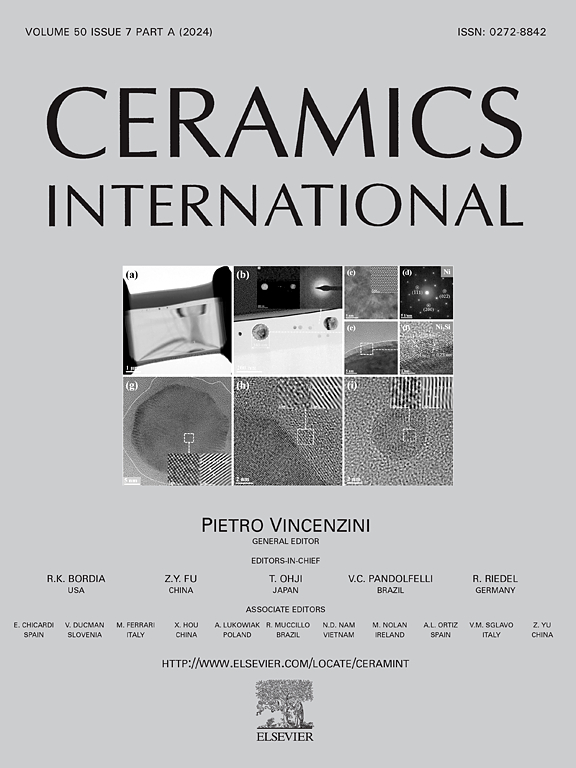无溶剂聚对二甲苯防水性涂料提高氮化铝的耐水解性和环氧复合材料的导热性
IF 5.6
2区 材料科学
Q1 MATERIALS SCIENCE, CERAMICS
引用次数: 0
摘要
氮化铝(AlN)陶瓷材料在最先进的电子器件和半导体中的应用正在迅速扩大。然而,生AlN容易被快速水解,其高昂的储存费用阻碍了其广泛使用。本研究利用旋转粉末涂布机对原AlN进行聚对二甲苯C涂层的改性,以提高环氧复合材料的耐水解性和导热性。利用显微作图图像、x射线衍射、x射线光电子能谱和傅里叶变换红外光谱结果对涂层前后AlN粉末进行表征,并确定其抗水解机理。聚对二甲苯改性影响了AlN表面的疏水性,水接触角增大到144°。在100%的湿度和50℃的温度下,改性后的粉末不被水解。在对聚对二甲苯C进行热处理的过程中,热解单体发生聚合,并与AlN核形成机械键。在AlN晶体表面形成的8 nm厚的保护层防止了水分子的攻击,阻碍了AlN的水解。此外,聚对二甲苯C结构与环氧基相互作用,提高了复合材料的导热性。本研究研究了一种简单但可扩展的策略来提高AlN粉末的抗水解性能和聚合物复合材料的准各向同性导热性。本文章由计算机程序翻译,如有差异,请以英文原文为准。
Solvent-free water-repellent parylene coating to enhance hydrolysis resistance of aluminum nitride and thermal conductivity of epoxy composites
The utilization of aluminum nitride (AlN) ceramic materials in state-of-the-art electronic devices and semiconductors is rapidly expanding. However, raw AlN is subject to rapid hydrolysis, and its exorbitant storage expense impedes its widespread use. In this study, raw AlN was modified by applying a coating of parylene C using a rotary powder coating machine to improve the hydrolysis resistance and thermal conductivity of epoxy composites. Microscopic mapping images, along with X-ray diffraction, X-ray photoelectron spectroscopy, and Fourier transform infrared spectrometry results were used to characterize the AlN powder before and after the coating process, and the mechanism of the hydrolysis resistance was determined. Modification with parylene C affected the hydrophobicity of the AlN surface, with the water contact angle increasing to 144°. The modified powder was not hydrolyzed under 100 % humidity and a temperature of 50 °C. During the heat treatment of the parylene C, the pyrolyzed monomers were polymerized and formed mechanical bonds with the AlN core. The protective 8 nm-thick layer that formed on the surface of the AlN crystal prevented attack by water molecules and hindered the hydrolysis of the AlN. Furthermore, the parylene C structure interacted with an epoxy matrix, which improved the thermal conductivity of the composite. This study investigated a facile but scalable strategy to enhance the anti-hydrolysis property of AlN powder and quasi-isotropic thermal conductivity of polymer composites.
求助全文
通过发布文献求助,成功后即可免费获取论文全文。
去求助
来源期刊

Ceramics International
工程技术-材料科学:硅酸盐
CiteScore
9.40
自引率
15.40%
发文量
4558
审稿时长
25 days
期刊介绍:
Ceramics International covers the science of advanced ceramic materials. The journal encourages contributions that demonstrate how an understanding of the basic chemical and physical phenomena may direct materials design and stimulate ideas for new or improved processing techniques, in order to obtain materials with desired structural features and properties.
Ceramics International covers oxide and non-oxide ceramics, functional glasses, glass ceramics, amorphous inorganic non-metallic materials (and their combinations with metal and organic materials), in the form of particulates, dense or porous bodies, thin/thick films and laminated, graded and composite structures. Process related topics such as ceramic-ceramic joints or joining ceramics with dissimilar materials, as well as surface finishing and conditioning are also covered. Besides traditional processing techniques, manufacturing routes of interest include innovative procedures benefiting from externally applied stresses, electromagnetic fields and energetic beams, as well as top-down and self-assembly nanotechnology approaches. In addition, the journal welcomes submissions on bio-inspired and bio-enabled materials designs, experimentally validated multi scale modelling and simulation for materials design, and the use of the most advanced chemical and physical characterization techniques of structure, properties and behaviour.
Technologically relevant low-dimensional systems are a particular focus of Ceramics International. These include 0, 1 and 2-D nanomaterials (also covering CNTs, graphene and related materials, and diamond-like carbons), their nanocomposites, as well as nano-hybrids and hierarchical multifunctional nanostructures that might integrate molecular, biological and electronic components.
 求助内容:
求助内容: 应助结果提醒方式:
应助结果提醒方式:


